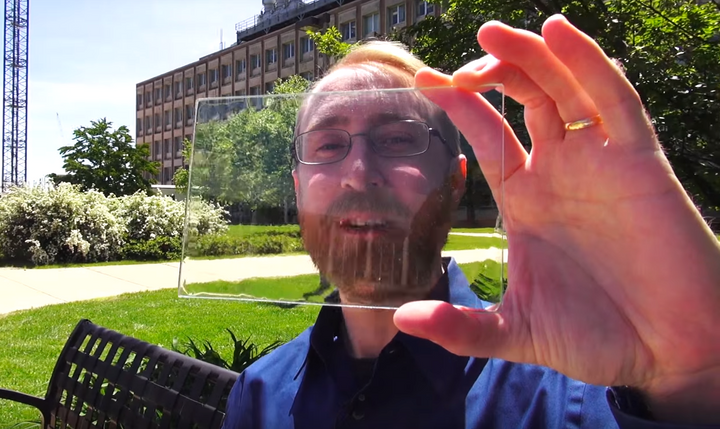Transparent solar panels could be a game-changer for renewable energy
– Stephanie Lu
In the idyllic image of the American home, transparent solar panels may soon be as ubiquitous as the proverbial white-picket fence.
Imagine the Louvre’s iconic glass pyramid as a beacon of energy —literally, not metaphorically. As more than 9 million visitors walk through the Paris museum each year, the building could be passively providing power to the entire city. Thanks to researchers at Michigan State University, this futuristic image of the world may soon become an accessible reality.
As the cost of installing solar panels has dropped, falling 80 percent between 2008 and 2015, solar panels have become an increasingly common accessory for middle-income and working-class households. In the U.S. alone, nearly 645,000 homes and businesses have turned to solar as a primary source of alternative energy, according to a solar industry trade group. In the idyllic image of the American home, solar panels may soon be as ubiquitous as the proverbial white-picket fence.
While photovoltaic (PV) cells, first discovered in the 1950s, have been the dominant source for solar power, concentrating solar power (CSP) technology has been rising in popularity in recent years. Though PV solar panels draw clear benefits like their accessibility and practicality, two questions then arise: how can solar energy technology advance, and where will the solar power trend turn next?
In the idyllic image of the American home, solar panels may soon be as ubiquitous as the proverbial white-picket fence.
Both of those questions may have found an answer in East Lansing, Michigan, where Richard Lunt and a team of researchers with Michigan State University revamped the concept of the solar concentrator by creating a new transparent material, the “transparent luminescent solar concentrator” (TLSC). Its purpose is simple but revolutionary: it’s a clear plastic that can be placed over any window or pane of glass to harvest solar energy.
Compared to how solar energy has functioned through PV cells, the method used by the transparent solar cell is somewhat counterintuitive. In the most basic terms, solar PV cells capture the photons and convert those pockets of light into electricity. By contrast, a transparent cell would allow the light to pass directly through, without capturing the photons.
While layering solar cells over plastic materials is far from original, past attempts have been ineffective, encountering issues with low energy yields and materials that were colored, rather than transparent. MSU’s scientists overcame these obstacles after discovering a class of organic salts that directly target specific nonvisible wavelengths of sunlight. Since infrared or ultraviolet light is undetectable by the human eye, the solar cells with the solar concentrator method have the transparency attribute. The solar cells capture ultraviolet and near infrared wavelengths, which then become a “glowing” infrared light. At the edge of the plastic, the PV solar cells then convert the light into electricity. In short, the purpose of the TLSC is to turn a window or sheet of glass into a PV solar cell in order to produce solar energy.
Transparency is not the sole defining characteristic of the TLSC — it’s also flexible, and with that characteristic come a host of benefits. “Solar-harvesting surfaces” can be hidden in plain sight without obstructing any view or causing any inconvenience, whether in the windowpanes of skyscrapers or on the screens of cell phones.
For MSU’s researchers, the final remaining hurdle is to maximize the energy-producing efficiency of the solar concentrator. Before going into the market, TLSC should aim to have a minimum conversion efficiency of five percent. Though Lunt and his team believe they’ll be able to reach ten percent efficiency, right now, their conversion efficiency hovers around one percent.
The innovation has arrived, so the next step is to bring this technology of transparent solar panels to the market. Lunt has cofounded a startup, Ubiquitous Energy, which is now at the brink of bringing the TLSC out of the research lab and into consumers’ hands, potentially changing any glass object — whether the Louvre’s glass pyramid or the common cellphone — into a conductor of electricity.
* * *
Further reading
Jamie Lendino, “A fully transparent solar cell that could make every window and screen a power source,” Extreme Tech, April 20, 2015.
“Solar Energy That Doesn't Block the View,” Michigan State University, August 19, 2014.
Photo courtesy of Michigan State University
